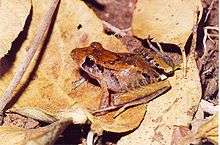Ischnocnema
Ischnocnema is a genus of frogs from eastern Brazil and north-eastern Argentina.[1][2][3] They comprise the former Eleutherodactylus from this region,[4] but they are closer to Brachycephalus than the "true" Eleutherodactylus. Consequently, they are now placed in their own genus Ischnocnema in the family Brachycephalidae.[1][2][3]
| Ischnocnema | |
|---|---|
 | |
| Ischnocnema izecksohni | |
| Scientific classification | |
| Kingdom: | Animalia |
| Phylum: | Chordata |
| Class: | Amphibia |
| Order: | Anura |
| Family: | Brachycephalidae |
| Genus: | Ischnocnema Reinhardt and Lütken, 1862 |
| Type species | |
| Leiuperus verrucosus Reinhardt and Lütken, 1862 | |
| Diversity | |
| Ssee text | |
Species
The following species: are recognised in the genus Ischnocnema:[1][2]
- Ischnocnema abdita Canedo and Pimenta, 2010
- Ischnocnema bocaina Taucce et al., 2020
- Ischnocnema bolbodactyla (Lutz, 1925)
- Ischnocnema colibri Taucce, Canedo, Parreiras, Drummond, Nogueira-Costa, and Haddad, 2018
- Ischnocnema concolor Targino, Costa, and Carvalho-e-Silva, 2009
- Ischnocnema epipeda (Heyer, 1984)
- Ischnocnema erythromera (Heyer, 1984)
- Ischnocnema feioi Taucce, Canedo, and Haddad, 2018
- Ischnocnema garciai Taucce, Canedo, and Haddad, 2018
- Ischnocnema gehrti (Miranda-Ribeiro, 1926)
- Ischnocnema gualteri (Lutz, 1974)
- Ischnocnema guentheri (Steindachner, 1864)
- Ischnocnema henselii (Peters, 1870)
- Ischnocnema hoehnei (Lutz, 1958)
- Ischnocnema holti (Cochran, 1948)
- Ischnocnema izecksohni (Caramaschi and Kisteumacher, 1989)
- Ischnocnema juipoca (Sazima and Cardoso, 1978)
- Ischnocnema karst Canedo, Targino, Leite, and Haddad, 2012
- Ischnocnema lactea (Miranda-Ribeiro, 1923)
- Ischnocnema manezinho (Garcia, 1996)
- Ischnocnema melanopygia Targino, Costa, and Carvalho-e-Silva, 2009
- Ischnocnema nanahallux Brusquetti, Thome, Canedo, Condez, and Haddad, 2013
- Ischnocnema nasuta (Lutz, 1925)
- Ischnocnema nigriventris (Lutz, 1925)
- Ischnocnema octavioi (Bokermann, 1965)
- Ischnocnema oea (Heyer, 1984)
- Ischnocnema paranaensis (Langone and Segalla, 1996)
- Ischnocnema parnaso Taucce, Canedo, Parreiras, Drummond, Nogueira-Costa, and Haddad, 2018
- Ischnocnema parva (Girard, 1853)
- Ischnocnema penaxavantinho Giaretta, Toffoli, and Oliveira, 2007
- Ischnocnema pusilla (Bokermann, 1967)
- Ischnocnema randorum (Heyer, 1985)
- Ischnocnema sambaqui (Castanho and Haddad, 2000)
- Ischnocnema spanios (Heyer, 1985)
- Ischnocnema surda Canedo, Pimenta, Leite, and Caramaschi, 2010
- Ischnocnema venancioi (Lutz, 1958)
- Ischnocnema verrucosa Reinhardt and Lütken, 1862
- Ischnocnema vizottoi Martins and Haddad, 2010
gollark: Can't misallocate resources if you don't have resources!
gollark: Good of everyone to use the non-heretical dark theme!
gollark: It was probably transparent.
gollark: Please stop just "X = Y"ing, it's not helpful.
gollark: …
References
- "Brachycephalidae". AmphibiaWeb: Information on amphibian biology and conservation. [web application]. Berkeley, California: AmphibiaWeb. 2014. Retrieved 27 December 2014.
- Frost, Darrel R. (2014). "Ischnocnema Reinhardt and Lütken, 1862". Amphibian Species of the World: an Online Reference. Version 6.0. American Museum of Natural History. Retrieved 27 December 2014.
- Hedges, S. B.; Duellman, W. E. & Heinicke, M. P. (2008). "New World direct-developing frogs (Anura: Terrarana): Molecular phylogeny, classification, biogeography, and conservation" (PDF). Zootaxa. 1737: 1–182.
- Heinicke, M. P.; W. E. Duellman & S. B. Hedges (2007). "Major Caribbean and Central American frog faunas originated by ancient oceanic dispersal". Proceedings of the National Academy of Sciences of the United States of America. 104 (24): 10092–10097. doi:10.1073/pnas.0611051104. PMC 1891260. PMID 17548823.
This article is issued from Wikipedia. The text is licensed under Creative Commons - Attribution - Sharealike. Additional terms may apply for the media files.